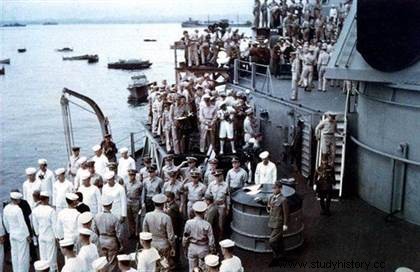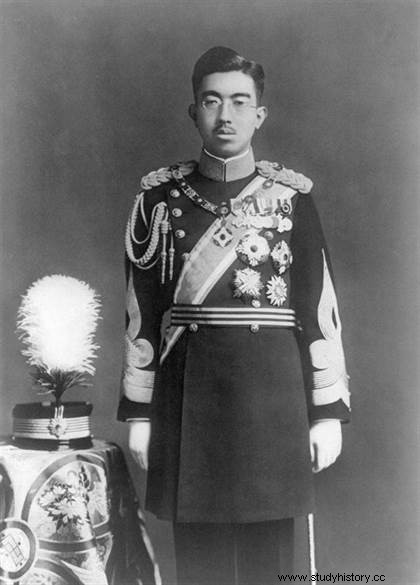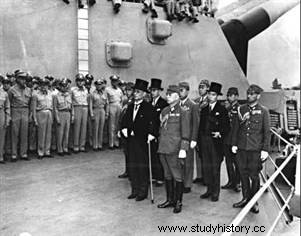 The bombings of Hiroshima and Nagasaki on August 6 and 9 precipitate Japan's surrender, September 2, 1945 . The formal surrender is signed aboard the US battleship Missouri in Tokyo Bay, and marks the end of World War II. Begun on December 7, 1941 at Pearl Harbor, the Pacific War saw hundreds of thousands of fighters face off in the largest theater of operations in the world, in a war that was both land and airborne. At the end of the conflict, Japan had about two million dead. Nearly 40% of the cities and all of the country's economic structures are destroyed.
The bombings of Hiroshima and Nagasaki on August 6 and 9 precipitate Japan's surrender, September 2, 1945 . The formal surrender is signed aboard the US battleship Missouri in Tokyo Bay, and marks the end of World War II. Begun on December 7, 1941 at Pearl Harbor, the Pacific War saw hundreds of thousands of fighters face off in the largest theater of operations in the world, in a war that was both land and airborne. At the end of the conflict, Japan had about two million dead. Nearly 40% of the cities and all of the country's economic structures are destroyed.
Attempts by the “peace party”
Already damaged by the setbacks of 1942, the credit of the war party was definitively reduced to nothing by the nuclear bombardments of Hiroshima and Nagasaki. The massive bombardments have not ceased on the Japanese archipelago since the end of 1944, but the atomic horror is so unexpected that on August 15, 1945, the Japanese radio announces that the emperor himself will speak, for the first times in twenty years of reign.
The intervention of the mikado announces the official capitulation, the reason given being the desire for peace in the face of the horror of the new American weapon. However, a posteriori the defeat seemed inevitable, atomic weapon or not. The euphoria of late 1941 and early 1942 quickly gave way to doubt in certain Japanese power circles, including the Emperor's closest adviser:Marquis Kido. The latter, despite failures during the years 1942 and 1943, obtained the support of Prince Konoye. The year 1944 then seems decisive:Kido plans to get closer to the Soviet Union, and he is supported in this by the Minister of Foreign Affairs Mamoru in person.
It is however difficult for this party of peace to obtain the support of the population, indoctrinated by the hardliners of the Empire, and this despite the intensification of the American bombardments at the end of 1944. However, in October of that same year, Prime Minister Tojo had to relinquish power, and with him a good part of the “war party”. The Imperial Navy admits that it is no longer able to engage in offensive operations. On November 7, the Soviet danger materialized when Stalin placed Japan among the aggressors of the USSR.
Difficulty accepting the idea of defeat
The end of the year 1944 and the beginning of the year 1945 are for Japan the real signs of the approaching rout:in addition to the increasingly deadly bombardments on the archipelago itself, the Japanese Empire lost the Philippines, the Marianas, then Okinawa, the last step before Japan itself.
 Yet the peace party still has to hide. Kido and Konoye manage to meet the Emperor, who begins to worry about the situation. But they must remain discreet, the soldiers being always threatening in spite of the departure of Tojo. The peace party nevertheless manages to bring to power the respected Admiral Suzuki, who is also in favor of a quick peace, normally. But the new head of the Japanese government was still wasting time in indecision, and in April 1945 the peace party had made little progress. It must be said that even on this side, the decision to capitulate to the enemy is difficult to take, in no way did the diplomats as much as the soldiers (and even the population) consider any reality of defeat since the successes of the Japanese Empire during the 1930s. The Japanese mentality of the time was not prepared for it. Potsdam's stab
Yet the peace party still has to hide. Kido and Konoye manage to meet the Emperor, who begins to worry about the situation. But they must remain discreet, the soldiers being always threatening in spite of the departure of Tojo. The peace party nevertheless manages to bring to power the respected Admiral Suzuki, who is also in favor of a quick peace, normally. But the new head of the Japanese government was still wasting time in indecision, and in April 1945 the peace party had made little progress. It must be said that even on this side, the decision to capitulate to the enemy is difficult to take, in no way did the diplomats as much as the soldiers (and even the population) consider any reality of defeat since the successes of the Japanese Empire during the 1930s. The Japanese mentality of the time was not prepared for it. Potsdam's stab
Japan under nuclear fire
Despite everything, faced with the scale of the losses and the approaching threat of invasion, even the war party, led by Minister Anami, is beginning to revise its ambitions on the decline. He is willing to renegotiate Potsdam. It is unfortunately too late, the Japanese have wasted too much time with their indecision and the fear of seeing the imperial throne disappear. The United States, also pressed by Soviet ambitions, atomized Hiroshima on August 6, 1945, and three days later Nagasaki. In accordance with the Yalta Accords, the USSR declared war on Japan on August 8 and invaded Manchuria the following day.
Panic is total in Tokyo, and the goal is soon only to save the imperial throne, despite the nuclear threat on the capital itself! It took several hours for Japanese officials to come to their senses and come to terms with the facts in order to finally admit the obligation to capitulate. The Potsdam clauses are finally accepted by the Togolese Minister of Foreign Affairs, but the military insists on avoiding an occupation of the country. Prime Minister Suzuki then asked the Emperor himself to choose between the Togo option and that of the military.
September 2, 1945:Japan's surrender
 August 10, 1945, Japan announced its desire to capitulate but it took several days to settle the details…which are not. Indeed, it is a question of knowing what will become of the emperor. The American Secretary of State, Byrnes, announces that the Emperor will be "subordinate to the Supreme Commander for the Allied Powers", which provokes new anger among the Japanese military. The discussions continued for the following days, but in the end the emperor chose the party of peace, and the cabinet validated the decision unanimously. The speech of August 15 by the emperor himself announces the capitulation of Japan and must stifle in the bud the inclinations of extremists of all persuasions who would have liked to take advantage of the instability of the regime. However, this did not prevent an attempted plot, which fortunately failed on the night of August 14. The Minister of War, Anami, committed suicide, followed by several other leaders of the "war party".
August 10, 1945, Japan announced its desire to capitulate but it took several days to settle the details…which are not. Indeed, it is a question of knowing what will become of the emperor. The American Secretary of State, Byrnes, announces that the Emperor will be "subordinate to the Supreme Commander for the Allied Powers", which provokes new anger among the Japanese military. The discussions continued for the following days, but in the end the emperor chose the party of peace, and the cabinet validated the decision unanimously. The speech of August 15 by the emperor himself announces the capitulation of Japan and must stifle in the bud the inclinations of extremists of all persuasions who would have liked to take advantage of the instability of the regime. However, this did not prevent an attempted plot, which fortunately failed on the night of August 14. The Minister of War, Anami, committed suicide, followed by several other leaders of the "war party".
The surrender of the Japanese armies is officially signed on the deck of the battleship Missouri in Tokyo Bay, on September 2, 1945, during a ceremony presided over by General MacArthur. At the head of the American occupation troops (1945-1950), the latter would play a decisive political role in the demilitarization of Japan and in its democratic transition.
Non-exhaustive bibliography
- P. Souty, The Pacific War 1937-1945, PUL, 1995.
- F. Garçon, The Pacific War, Casterman, 1997.
- J. Costello, The Pacific War, 2 volumes, Pygmalion, 1982.
- The Second World War, Jules Tallandier editions, 7 volumes, 1966.
